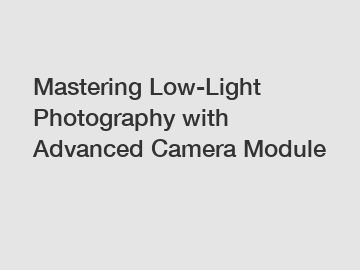Mastering Low-Light Photography with Advanced Camera Module
Apr. 06, 2024
When it comes to photography, one of the biggest challenges that many photographers face is mastering low-light photography. Whether you're shooting in dimly lit interiors, capturing the twinkling lights of a city skyline at night, or trying to freeze a fast-moving subject in the dark, low-light conditions can be a real test of your skills.
But fear not! With advances in camera technology and the availability of advanced camera modules, mastering low-light photography has become easier than ever before. In this blog post, we'll explore some tips and techniques to help you take your low-light photography to the next level using an advanced camera module.
One of the key factors in low-light photography is the sensitivity of your camera's sensor to light. The higher the ISO setting on your camera, the more sensitive it is to light, allowing you to capture more detail in low-light conditions. However, high ISO settings can also introduce noise into your images, so it's important to strike a balance between a high enough ISO to capture the scene and a low enough ISO to maintain image quality.

With an advanced camera module, you have more control over the ISO settings, allowing you to fine-tune the sensitivity to suit the lighting conditions. Experiment with different ISO settings to find the optimal balance between capturing detail and minimizing noise in your low-light shots.
Another important factor in low-light photography is the aperture of your lens. The wider the aperture (smaller f-stop number), the more light your lens can let in, which is crucial in low-light situations. With an advanced camera module, you can choose lenses with wider apertures, such as f/1.8 or f/2.8, to maximize the amount of light reaching your camera's sensor.
When shooting in low light, it's also important to pay attention to your shutter speed. In dimly lit environments, you'll need a slower shutter speed to allow enough light to reach the sensor. However, a slow shutter speed can also result in motion blur if your subject is moving. With an advanced camera module, you have the ability to adjust the shutter speed to freeze motion while still capturing a well-exposed image in low-light conditions.
One of the biggest advantages of using an advanced camera module for low-light photography is the option to shoot in RAW format. RAW files contain more information than JPEGs, allowing you to make more precise adjustments to exposure, color, and white balance in post-processing. This flexibility can be a game-changer when it comes to fine-tuning your low-light shots and bringing out the best in your images.
In addition to technical settings, composition plays a crucial role in low-light photography. Look for interesting light sources, such as street lamps, neon signs, or the glow of a sunset, to create captivating images in low-light conditions. Experiment with different angles and perspectives to make the most of the available light and create visually striking compositions.
Furthermore, don't be afraid to use creative techniques such as long exposure photography to capture the magic of low-light scenes. By using a slow shutter speed and a tripod to stabilize your camera, you can create mesmerizing light trails, silky waterfalls, and dreamy nightscapes that will elevate your low-light photography to a whole new level.
Ultimately, mastering low-light photography with an advanced camera module is a combination of technical know-how, creative vision, and a willingness to experiment and push the boundaries of what's possible in challenging lighting conditions. By understanding your camera's capabilities, fine-tuning your settings, and honing your composition skills, you can capture breathtaking low-light images that showcase the beauty and mystery of the world after dark.
So grab your camera, head out into the night, and let your creativity shine as you master the art of low-light photography with an advanced camera module. With the right tools and techniques at your disposal, the possibilities are endless, and the results will speak for themselves in stunning, captivating images that will leave viewers in awe of your talent and skill.
If you want to learn more, please visit our website Camera module for professional photography, Camera module promotion, Zoom Camera Module.
21
0
0

Comments
All Comments (0)